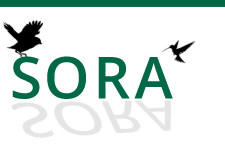Some Nesting Habits of the Pled-billed Grebe
Online Full Text
There seems to be some uncertainty among authorities as to the sitting habits of the Pied-billed Grebe (Podilymbus podiceps). I was fortunate enough, on June 9, 1920, to surprise one of these birds on its nest in such a way as to prove, to my own satisfaction at least, that it was incubating its eggs in normal fashion.
I was driving along the county road from Firebaugh to Merced, California, watching the bordering tule patches closely, when I saw one of these grebes sitting. I stopped my machine and immediately the bird became suspicious, but did not move. Undoubtedly she had become used to automobiles passing. There was a small pond in the ditch by the roadside and in this the nest was floating. It was not more than twelve or fifteen feet from me and the black band across the bird’s bill was easily noticeable
My son and I watched her for several minutes, all of us remaining motionless. Then the boy left the car on the farther side without the grebe having seen him. When he came around the end of the auto and she could see him she immediately slipped into the water.
As she half rose preparatory to leaving, I could see her eggs, very clearly and distinctly. But the most interesting thing was to watch her cover them. Her body moved without a pause, yet the bird contrived to take three quick pecks at the sides of her nest, pulling the material in her bill under her body. The time consumed was about twice what a chicken would take to peck three mouthfuls from a feed bin; approximately two seconds, I estimate. In any event there was no perceptible time lost. She seemed to leave the nest as easily and as quickly as any other bird. But when we reached it, not a speck of any part of her six eggs was visible.
Mr. Bent (page 42 of his “Life Histories of North American Diving Birds”) states that the young “cling tenaciously to the parent bird while she dives and brings them up again.” On June 25, 1919, I saw a Pied-billed Grebe with three young that could hardly have been more than 24 hours old. When I first noticed them the babies were sitting on the mother's back, a very pretty sight. At my approach she dove and left them bobbing on the surface of the water like so many corks. She came up a few yards away and at once they all swam to her and climbed aboard. This process was repeated several times and not once was one of the babies dragged under at all.
I must apologize for my use of the pronoun “she”. Of course I had no means of knowing the sex of the parent bird in either of the above cases.
San Diego, California, September 11, 1920
Creative Commons License
Recommended Citation
Bancroft, Griffing
(1920)
"Some Nesting Habits of the Pled-billed Grebe,"
Condor: Vol. 22
:
Iss.
6
, Article 11.
Available at:
https://digitalcommons.usf.edu/condor/vol22/iss6/11

